Lab Safety Rules
modified
from http://nobel.scas.bcit.ca/debeck_pt/science/safety.htm
for
use with
Online Virtual Laboratory Activities
GENERAL GUIDELINES
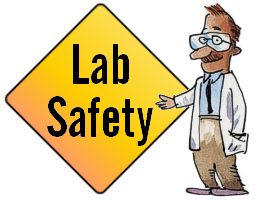
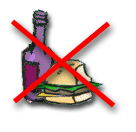
1.
Be alert and responsible at all times in the laboratory.
(This applies to both Virtual and Actual Laboratories!)
2.
Follow all written and verbal instructions carefully. If you do
not understand a direction or part of a procedure, ASK BEFORE PROCEEDING
WITH THE ACTIVITY.
(In the Virtual Laboratory, use the Help Pages
for support as well.)
3.
Never work alone in the laboratory. No student may work in the
science classroom without the presence of the teacher.
(Of course, you may work alone in the Virtual
Laboratory, but your instructor will be aware of what you are doing.)
4.
When first entering a science room, do not touch any equipment, chemicals,
or other materials in the laboratory area until you are instructed to
do so.
(In the Virtual Laboratory, make sure you read all the instructions
and procedures before you start the activities and simulations)
5.
Perform only those experiments authorized by your teacher. Carefully
follow all instructions, both written and oral. Unauthorized experiments
are not allowed.
(In the Virtual Laboratory, the instructor may
ask you to explore the use of different equipment, but you should follow
the instructions in the Virtual Lab Environment for the proper use of
the equipment, materials, and chemicals.)
6.
Do not eat food, drink beverages, or chew gum in the laboratory.
Do not use laboratory glassware as containers for food or beverages.
(In the Virtual Laboratory, be careful to keep
liquids and foods away from your computer!)
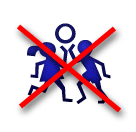


7.
Be prepared for your work in the laboratory. Read all procedures
thoroughly before entering the laboratory. Never fool around
in the laboratory.
(In the Virtual Laboratory, read all the procedures before you start
the labs and make sure you understand what you are expected to do
and how you are expected to report the results. Fooling around
may result in the Virtual Labs freezing up and/or loss of your data
and other records.....requiring you to restart!)
8.
Always work in a well-ventilated area.
(In the Virtual Lab, make sure that the room
where your computer is located is well-ventilated, that you have adequate
light, and that you are in a comfortable position for using the computer
controls.)
9.
Observe good housekeeping practices. Work areas should be kept
clean and tidy at all times.
(In the Virtual Laboratory, your work space should
be neat as well! You will need to arrange the computer windows so that
you can read instructions, record results, and use the Virtual Lab space)
10.
Be alert and proceed with caution at all times in the laboratory.
Notify the teacher immediately of any unsafe conditions you observe.
(In the Virtual Laboratory, notify the instructor
if there are problems with the virtual lab instructions.)
11.
Dispose of all chemical waste properly. Never mix chemicals in
sink drains. Sinks are to be used only for water. Check with your
teacher for disposal of chemicals and solutions.
(In the Virtual Laboratory, follow the instructions
for resetting the lab workspace and for disposing of chemicals and solutions...yes,
you will need to do this for Virtual Lab activities!)
12.
Labels and equipment instructions must be read carefully before use.
Set up and use the equipment as directed by your teacher.
(This is just as important in the Virtual Laboratory
as in the physical laboratory! Set up and use the equipment and materials
as described in the procedures. Always do the initial laboratory procedures
that demonstrate how to use the specific components of each Virtual
Lab activity.)
13.
Keep hands away from face, eyes, mouth, and body while using chemicals
or lab equipment. Wash your hands with soap and water after performing
all experiments.
(This just makes good sense. You should always wash your hands after
using the computer as well, particularly if you are using a computer
that is shared with others in a computer lab or classroom.)
14.
Experiments must be personally monitored at all times. Do not
wander around the room, distract other students, startle other students,
or interfere with the laboratory experiments of others.
(In the Virtual Laboratory, make sure that you
follow the instructions for saving and recording your data and responses.
Virtual Laboratory environments differ in how you will report results
and prepare lab reports: Some may be recorded directly in the Virtual
Laboratory and some may need to be recorded separately, in a WORD or
EXCEL documents, for example. Make sure you have saved your results
and reports BEFORE you exit the Virtual Laboratory....so you won't have
to repeat everything!)
15.
Know the locations and operating procedures of all safety equipment
including: first aid kit(s), and fire extinguisher. Know where
the fire alarm and the exits are located.
(This is important whether your Virtual Laboratory
is located on your home computer or in a school or library computer
lab/classroom. Know what to do, where to go, and whom to call in an
emergency!)
16.
Know what to do if there is a fire drill during a laboratory period;
containers must be closed, and any electrical equipment turned off.
(This is important whether your Virtual Laboratory
is located on your home computer or in a school or library computer
lab/classroom. Know what to do, where to go, and whom to call in an
emergency!)
CLOTHING
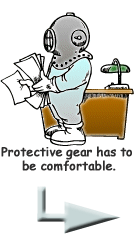
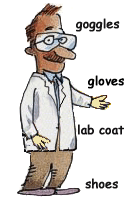
17.
Any time chemicals, heat, or glassware are used, students will wear
safety goggles. NO EXCEPTIONS TO THIS RULE!
(Well, actually, the exception to this rule is
when you are doing online virtual experiments in the Virtual Laboratory!)
18.
Contact lenses may be not be worn in the laboratory.
(But they may, of course, be worn in the Virtual
Laboratory.)
19.
Dress properly during a laboratory activity. Long hair, dangling
jewelry, and loose or baggy clothing are a hazard in the laboratory.
Long hair must be tied back, and dangling jewelry and baggy clothing
must be secured. Shoes must completely cover the foot. No
sandals allowed on lab days.
(Of course, in the Virtual Laboratory, these rules
don't apply. If you are conducting the Virtual Laboratory in a computer
lab/classroom, you must obey the dress code regulations of that location!)
20.
A lab coat or smock should be worn during laboratory experiments.
(And you may want to do this while performing
activities in the Virtual Laboratory, but you don't need to do so!)
ACCIDENTS AND INJURIES
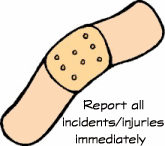
21.
Report any accident (spill, breakage, etc.) or injury (cut, burn, etc.)
to the teacher immediately, no matter how trivial it seems. Do
not panic.
(In the Virtual Laboratory, report any problems
with the virtual lab activities...and don't panic if your computer freezes
up, etc. Make sure that you have downloaded the proper software, browsers,
etc., and have sufficient computer memory before starting the Virtual
Laboratory. The Virtual Laboratory Environment does have help pages
and support!)
22. If you or your lab partner is hurt, immediately (and loudly) yell out the teacher's name to get the teacher's attention. Do not panic. (This is important whether your Virtual Laboratory is located on your home computer or in a school or library computer lab/classroom. Know what to do, where to go, and whom to call in an emergency! And always let someone know where you are going to be!)
23.
If a chemical should splash in your eye(s) or on your skin, immediately
flush with running water
for at least 20 minutes. Immediately (and loudly) yell out the
teacher's name to get the teacher's attention.
(Although this won't happen in the Virtual Laboratory,
you should know
what to do, where to go, and whom to call in an emergency, regardless
of where you are or what you are doing!)
HANDLING
CHEMICALS
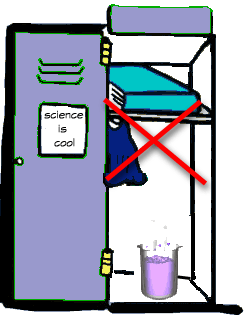
24.
All chemicals in the laboratory are to be considered dangerous. Avoid
handling chemicals with fingers. Always use a tweezer. When making an
observation, keep at least 1 foot away from the specimen. Do not taste,
or smell any chemicals. If the instructions ask you if a substance
(reactant or product) has an odor, hold the container away from you
and gently fan the fumes, if any, toward you. Never put your nose into
the container!
(In the Virtual Laboratory, follow the procedures for determining the
odor and other physical properties of chemicals)
25.
Check the label on all chemical bottles twice before removing any of
the contents. Take only as much chemical as you need.
(In the Virtual Laboratory, follow the procedures
for obtaining chemicals and for removing chemicals from their containers.
As in the actual laboratory, read the labels on all containers to make
sure you are using the correct chemicals....it is certainly possible
to take the incorrect chemicals by not reading the directions or the
containers correctly!)
26.
Never return unused chemicals to their
original container.
(In the Virtual Laboratory, the instructions may
ask you to do this. Please remember, that while this may be allowed
in the Virtual Laboratory, it is NEVER, NEVER allowed in the actual
laboratory!)
27.
Never
remove chemicals or other materials from the laboratory area.
(Of course, this won't be possible in the Virtual
Laboratory, but please remember, this is NEVER,
NEVER allowed in the actual laboratory!)
HANDLING
GLASSWARE
AND EQUIPMENT
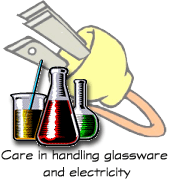
28. Never handle broken glass with your bare hands. Use a brush
and dustpan to clean up broken glass. Place broken glass in the
designated glass disposal container.
(This just makes good sense and refers to lab
situations or any other situation where there is broken glass! In the
Virtual Laboratory, there may be an occasion where glassware does break...follow
the instructions provided in the Virtual Laboratory for clean up!)
29.
Examine glassware before each use. Never use chipped, cracked,
or dirty glassware.
(In the Virtual Laboratory, make sure that you
know the names of the different types of glassware, and other equipment,
and how to use them properly.)
(In the Virtual Laboratory, use the HELP or Technical Support function.)
31.
Do not immerse hot glassware in cold water. The glassware may
shatter.
(This just makes good sense, regardless of where
you are! This may happen in the Virtual Laboratory! If it does, clean
up according to the Virtual Laboratory instructions.)
HEATING SUBSTANCES
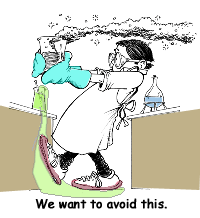
32.
Do not operate a hot plate by yourself. Take care that hair, clothing,
and hands are a safe distance from the hot plate at all times.
Use of hot plate is only allowed in the presence of the teacher.
(In the Virtual Laboratory, you will be using
hot plates and bunsen burners. You will be instructed in their proper
use as if you were in an actual laboratory.)
33.
Heated glassware remain very hot for a long time. They should
be set aside in a designated place to cool, and picked up with caution.
Use tongs or heat protective gloves if necessary.
(In the Virtual Laboratory, follow the procedures
carefully. In most cases, you will not be able to move heated objects
unless you have taken the proper virtual precautions.)
34.
Never look
into a container that is being heated.
(This is just common sense. While this will probably
not be an option in the Virtual Laboratory, it is an important safety
rule, whenever you encounter situations involving heating substances!)
35.
Do not place hot apparatus directly on the laboratory desk. Always
use an insulated pad. Allow plenty of time for hot apparatus to
cool before touching it.
(Generally, in the Virtual Laboratory, you will
be warned when a substance or a container needs to be cooled and be
instructed how to do this and how long to wait until proceeding. In
some circumstances, you will not be able to proceed until the temperature
gauge indicates that it is safe to do so.)
ANIMALS IN THE LABORATORY
![]()
(In the Virtual Laboratory, there is no danger of being bitten, but you should always treat animals with respect, regardless of whether they are alive, preserved, or virtual!)
